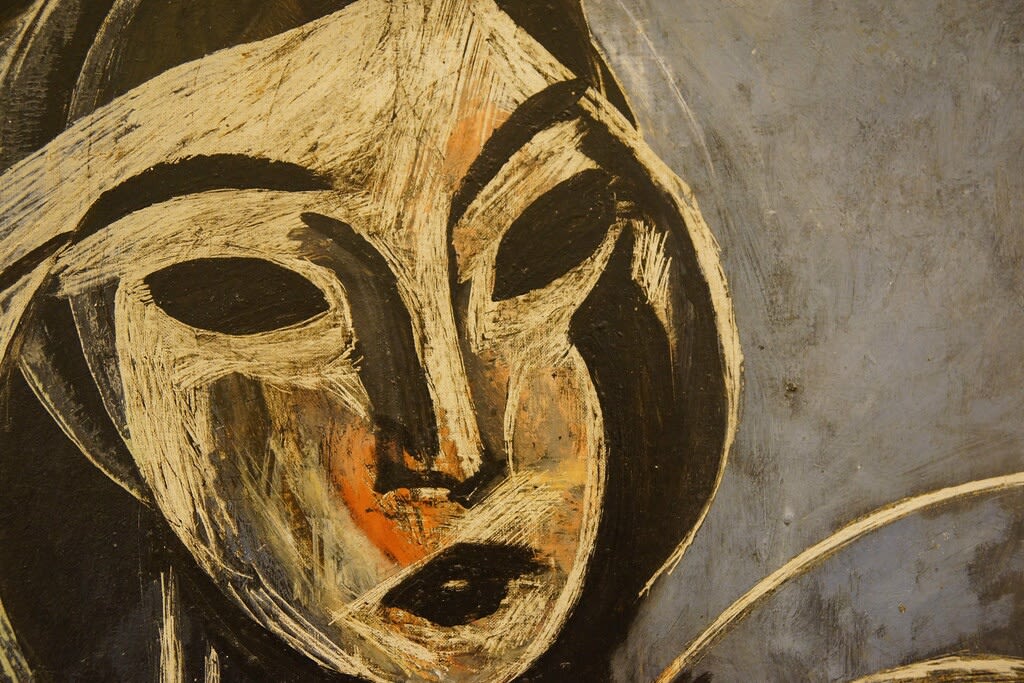
The Landsbergs were a wealthy family of Brazilian ex-patriots living in Paris at the time. Yvonne's brother, an admirer of Matisse's work and a friend of the artist, commissioned a drawing of sister, Yvonne in the spring of 1914.
A handful of sketches were produced by the artist before the final painting. What makes this drawing so exciting is that it allows us an insight into the artist’s creative process as a draughtsman and the changes that took place between this drawing and the final painting. This entire commission took place only weeks before the outbreak of World War I and illustrates Matisse’s transition as an artist from a joyful Fauvist concerned primarily with bold colours and brushstrokes, to one influenced by Cubism and affected by the challenging political discord that would forever change our world.

Matisse agreed to undertake the commission portrait of Yvonne, stipulating that he have complete freedom in its execution, and the family was under no obligation to purchase the finished painting. The portrait required many sittings and developed his ideas with drawings and also a number of prints. With each sitting, Matisse changed the image as the work progressed, and the figure became increasingly less naturalistic and more abstract. When unveiled, Yvonne’s brother, Albert remarked that he thought the finished painting looked like a Byzantine icon!

The process of making such a commissioned portrait demonstrates the duality and tension that Matisse felt between representing human likenesses and fulfilling his own expressive inclinations. The portrait remains a deep view into the personality of the subject and a girl on the verge of womanhood. Not only does the sketch itself present such an interesting story within the context of the famous final portrait, but the process and development of the final work is a study into the mind and workings of a genius.
John Elderfield in his book ‘The Drawings of Henri Matisse’, remarks, "The great drawing of Yvonne Landsberg [the present work] resembles an early state of the painting, as documented by a recent X-ray photograph. In this tense, austere drawing, Matisse eschews the ease of the other studies for rigorous contraction of the subject into rhyming sequences of summarily modelled forms. Face, breasts and pressed-together thighs recall that 'egg-like form beautiful in volume' Matisse had told his students to look for in a particular model, back in 1908; so does the hair, which indeed 'describes a protecting curve and gives a repetition that is a completion' [Sarah Stein]. Joining these forms, the branch-like neck and arms -- one broken abruptly at the elbow and wrist, the other wrenched downwards by the sheer force of turning and pulling the charcoal back into the body -- are rigid, jolting accents, yet possessed of an eloquent beauty of their own"
For over 55 years our London townhouse has had the pleasure to receive beautiful artworks that are a joy to share with our collectors. In the world, styles and the zeitgeist may change with popularity waxing and waning, but at Andipa our artworks, regardless of their epoque, continue to inspire.
Owner and direct, Acoris Andipa says, “The wonderous skill of Matisse is his simplicity, yet, shift any of his lines a millimetre or two either way, and what seems so beautiful and effortless becomes nothing more than a collection of charcoal lines. Within each fluid stroke is an emotion, and in this portrait of Yvonne, you can feel the innocence of a young girl embarking into early adulthood. I’m so delighted and honoured to have such a drawing, and the glimpse of time and method into one of modern art’s greatest masters”.
For more information and to view our Matisse sketches for sale, contact Andipa via sales@andipa.com or on +44 (0)20 7581 1244.